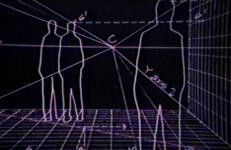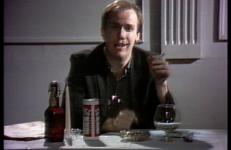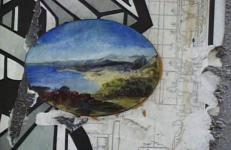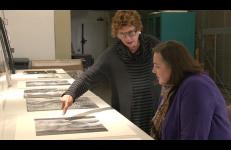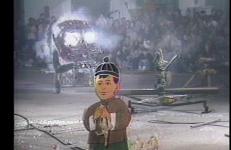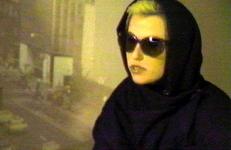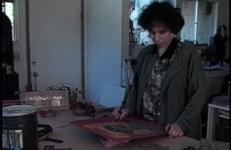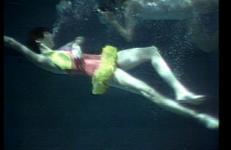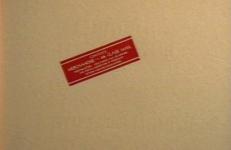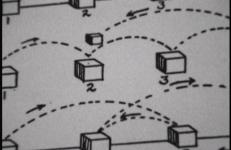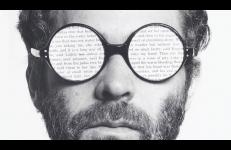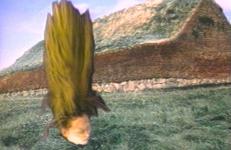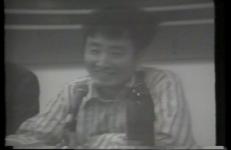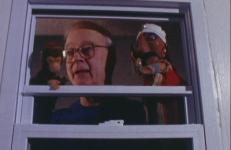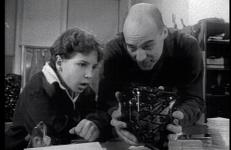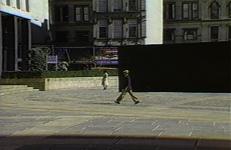Known as one of Italy's most important filmmakers, Pier Paolo Pasolini was first and foremost one of its poets. Combining staged and archival material, this elegiac essay considers Pasolini's brutal murder alongside the texts he published or left unfinished during the last year of his life.
Artist Portraits
In this episode of The Live! Show, hosted by Jaime Davidovich, Eric Bogosian brings seven characters to life in seven minutes, Michael Smith plays the best driver in the world, Mitchell Kriegman offers a helping hand during the show’s popular call-in segment, and Louis Grenier demonstrates the organic face lift viewers can do at home.
This tape examines the meaning, impact, and future of the early-1980s avant-garde through interviews with artists (Scott B., Robert Longo, Walter Robinson, Michael Smith), an art dealer (Helene Winer, Metro Pictures), a museum director (Marcia Tucker, The New Museum of Contemporary Art), and an art historian (Roselee Goldberg). “Whenever you feel confident that you know what’s happening at the outside edge, something’s always happening that you don’t know about. The avant-garde, if it exists at all... is determined by the artist, not the peripheral people like myself,” Tucker says.
Richard Prince appropriates images from commercial advertising and travelogues for his photographs. Choosing these images for their melodramatic, super-real power, he then isolates their stylistic realism to accentuate its rhetoric. In this portrait/performance, Prince narrates experiences that demonstrate his extreme sensitivity to appearances and context. He relates the event of buying his first car as the imprinting of a certain aesthetic impression.
This title is also available on Crossover Series.
Public Discourse is an in-depth study of illegal installation art. The primary focus is on the painting of street signs, advertising manipulation, metal welding, postering and guerrilla art, all performed illegally. Public Discourse is about passionate artists who want their work to be seen by a wide range of people rather than be confined to the systemic structures of galleries and museums.
Public Discourse is an in-depth study of illegal installation art. The primary focus is on the painting of street signs, advertising manipulation, metal welding, postering and guerrilla art, all performed illegally. Public Discourse is about passionate artists who want their work to be seen by a wide range of people rather than be confined to the systemic structures of galleries and museums.
Public Discourse is an in-depth study of illegal installation art. The primary focus is on the painting of street signs, advertising manipulation, metal welding, postering and guerrilla art, all performed illegally. Public Discourse is about passionate artists who want their work to be seen by a wide range of people rather than be confined to the systemic structures of galleries and museums.
Freed documents artist James Rosenquist at home in an East Hampton, N.Y studio in March 1972. Rosenquist and his collaborators work on a project entitled 47 Dirty Band Aids with blaring music dominating the environment while they paint. Somewhat ironically Rosenquist describes each colour for the black and white video as he applies it to a large panel. With the camera roaming between the two of them Freed interrogates Rosenquist in a quieter moment, probing him for the intentions and ultimate destination of his work.
Flesh meets robotics in this early video documentation of Survival Research Laboratory’s spectacular exhibitions of collective invention, anti-corporate technology, and satirical mass destruction. In the performances documented here, various animal corpses are integrated into the action as the clawed and spiked machines attack dummies, each other, and, occasionally, the audience. The video begins with the song Stairwell to Hell, an appropriate prologue.
Cindy Sherman received an MFA from the State University of New York at Buffalo in 1976, where she studied photography. During this time she was also involved with HallWalls, an alternative gallery space in Buffalo. She is best known for her black and white Untitled Film Stills, which she made in the late 70s and early 80s. In carefully designed settings, Sherman placed herself, using costumes, wigs, and makeup, in various scenarios suggetive of B-movies from the 1950s.
This tape profiles mother and daughter artists Betye and Alison Saar. Both artists work with sculpture and installation, frequently using found objects, wood, and sheet metal to evoke sacred African-American rituals and images. Similar Differences was produced in concert with their first collaborative exhibition in a decade, Secrets, Dialogues, Revelations, which opened at UCLA’s Wight Gallery in January 1990 and toured nationally in 1992.
Laurie Simmons’s photographs are brought to life in Laurie Simmons: A Teaser, MICA-TV’s portrait of the acclaimed photographer. In the early 1980s, Simmons focused on underwater photographs of women, which suggested the stylized tableaux of Esther Williams’s water ballets. Taping through a glass window in the bottom of a swimming pool, Michael Owen and Carole Ann Klonarides recorded Simmons while she was shooting her models.
For the past 20 years Alexis Smith's mixed media work has explored primal American myths: the open road, the bad/good guy/gal, the quest for romance, and the search for paradise. This portrait of the artist explores the roots of her thought and work, and was produced in conjunction with her exhibition at the Whitney Museum of American Art, held in November 1991.
Shot in Naples, Vienna, and New York, Some Chance Operations explores the notion of an archival form, in this instance film, as an unstable memory receptacle that can vanish. History and how it is made is meditated upon as one of many chance operations. The filmmaker Elvira Notari, who had a film production company in Naples from 1906 to 1930, plays a significant role as an impetus for Some Chance Operations. Despite the fact that she was a prolific filmmaker, producing over sixty feature films, only three remain intact.
“We lose good artists to the past all the time because their work was ephemeral, or difficult, or fashion wasn’t on their side. The performance artist Stuart Sherman, who died of AIDS in 2001, was a candidate for disappearance on all three counts.”
— New York Times, 2009
Sphinxes Without Secrets is an energetic and transgressive acount of outstanding female performance artists, and an invaluable document of feminist avant-garde work of the 70s and 80s. No Mona Lisa smiles here, as performance artists spill their guts about what outrages and delights them. Performers, curators, and critics unravel the mysteries of a new art form and ponder the world women confront today. Since its inception, performance art has provided a forum for artists who create work that challenges the dominant aesthetic and cultural status quo.
Tell Me About Your Mother investigates matrilineal lineage, domesticity and creativity. Intimate and conversational, seven female artist friends and colleagues of mine—mostly boomers—recount their mother’s creative influence upon them. Additionally, each woman discusses the unique way(s) she distinguished herself from her mother.
This tape is a media arts collaboration between Joe Leonardi, Cathleen Kane, and radio artist Joe Frank. It is a synthesis of three “dark humored” radio pieces adapted for video.
This tape was produced by Artists TV Network, documenting a symposium that included composer John Cage, choreographer Merce Cunningham, writer Richard Kostelanetz, and video artist Nam June Paik with art critic Dore Ashton serving as moderator. This freewheeling symposium taped before a live audience ranges from individual reminiscences to discussion of then-current art community concerns about music, literature, theater, art, dance, video, and technology.
The latest in Marie Losier's ongoing series of film portraits of avant-garde directors (George and Mike Kuchar, Guy Maddin, Richard Foreman), DreaMinimalist offers an insightful and hilarious encounter with Conrad as he sings, dances and remembers his youth and his association with Jack Smith.
Modeled after NBC’s long-running science program Watch Mr. Wizard, this tape features Torreano as Mr. Wizard instructing a skeptical boy on how to build a diamond out of pieces of wood. The boy remains unimpressed until Torreano uses a “video paintbox” to create flashy special effects. Painter John Torreano’s use of galaxy clusters as a reference for his fake jewel studded canvases and diamond-shaped sculptures suggested the nostalgic format of this video profile by MICA-TV.
The artwork on trial is Richard Serra's public sculpture, Tilted Arc, commissioned and installed by the U.S. government in 1981. Four years later, a public hearing was held to consider the removal of the sculpture from its site in Federal Plaza in New York City. In documenting the climatic General Services Administration hearing, The Trial Of Tilted Arc is a thought-provoking indictment of the state of the arts.
A short portrait of artist Anne Truitt (1921-2004). The film consists of an interview and 16mm footage made in and around her studio at the Yaddo artist colony, as well as footage from her home studio in Washington D.C. Rather than an attempt to depict her art, which is in many respects un-photographable, the core of the film is found in Truitt speaking about the course and meaning of her work. Says Cohen, "I was honored to know Anne Truitt, and doubly so when she allowed me to make a short record of her presence and thoughts.





